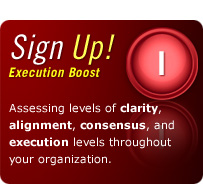The Five Keys to Building a Successful Company
by John Spence
July 1st, 2006
(The following is from a five-part series of short articles that John wrote for Gainesville Today Magazine on what it takes to build a successful organization)
During the course of the past five years I have had the opportunity to serve as a management consultant and corporate trainer to more than 300 companies worldwide. Working with these organizations in the areas of strategic planning, marketing, sales and leadership development I have been afforded a unique perspective of how companies in thirty different industries operate. What I have found is that regardless of the size of the organization, from small 2-3 person entrepreneurial enterprises, to 100,000 employee multi-national corporations, there are specific characteristics that clearly differentiate “Great” companies.
The first, and most important factor in successful companies is the existence of a clear, vivid, and compelling vision of exactly where the organization is headed. A vision that tells employees throughout the operation why they are coming to work, what they are working towards, and how it will look and feel once they achieve the vision. A vision that gets everyone excited about coming to work and contributing to the success of the organization and also shows the personal benefits of attaining corporate excellence.
What I am not talking about is some sterile “Vision Statement” handed down from the top. We have all seen the impressive looking engraved plaques that read: “The Acme Company will be the world leader in blah, blah, blah…” These are usually hung in every office in the company, yet completely invisible to all the employees. A real vision is built from the ground up by the people who will do the actual work to make it happen.
Through team meetings, surveys, and discussions over beers after work, the vision takes shape. The leader listens, watches and asks questions. Then the leader does something important, he or she takes the necessary time to sit down and think deeply about the vision and direction of the company, taking in all the input they have gathered to create a living vision that reflects the hopes and aspirations of the team and the realities of the marketplace.
After the vision has been developed there are still two critical tasks. Step one is to support the vision with SMART Goals: Specific, Measurable, Agreed Upon, Realistic, and Time Bound goals that are written down. These sort of detailed goals are absolutely essential to letting everyone in the organization know exactly what they should be doing on a daily basis to make the vision a reality.
The last step for ensuring the vision is effective is constant and consistent communication of the vision throughout the organization. Formally through memos, e-mail, and newsletters; informally through meeting and face-to-face communications, until the entire company is infused with a clear, vivid and exciting vision to their future success.
Article # 2
If the first requirement for running a successful organization is the creation of a vivid and compelling vision that is supported by a specific and measurable plan, the next step toward excellence must then be to take action on that plan.
As logical as this might seem, it is unfortunately all too rare in the business world. I find it curious that a number of the companies I’ve worked with invested significant time and effort in developing a strategic plan: then rendered it useless because it was never implemented. My partners and I call such plans “credenza-ware” because they only come off the shelf once a year at the annual meeting where a manager simply changes all of the dates to 12 months further out and puts it back to gather dust. In stark contrast, successful companies pay attention to the plan! They use it on an almost daily basis as a touchstone to guide them forward toward their vision.
I call this critical distinguishing feature of great companies: “a culture of urgency.” Every employee throughout the organization has a bias for action and is committed to turning the business plan… into a business reality.
But how do these organizations get people so focused on “making things happen?” First, employees must believe that the plan is solid or they will not give their full effort to implementation. This high level of buy-in is accomplished by getting the entire company involved in the planning process. If people have a say in building the plan they will have a much larger stake in making it work.
Other key ingredients include:
- Company policies that help people take action, as opposed to smothering them in unnecessary rules and red tape.
- Delegation for decision making down to the people closest to the customer. Every time an employee has to ask a manager to resolve a minor problem or answer a simple question – it wastes valuable time.
- Lots and lots of training for front-line employees – so they have the skills to make good decisions on their own.
- An abundance of open and honest communication so that people across the organization have the information needed to make good decisions quickly (this is so important it will be the topic of a the next article in this series).
- A compensation and reward system that strongly supports a culture of urgency and is tied directly into achieving the specific goals of the plan. Personal accountability for results is a must.
- And perhaps most important, a senior management team that exemplifies fast decision-making and clearly values employees that take action on the plan. Nothing is more detrimental to morale then having a committee take seven weeks to make a decision, then demand that the staff roll it out within 48 hours.
As the former commandant of the US Marine Corps once said: “A good plan violently executed, is better than a great plan un-acted upon.” The equation is rather simple; the level of success your company will achieve is in direct proportion to the amount of focused action you and your team can apply to your vision and plan. Make it as easy as possible for your people to serve the customer quickly and correctly – now!
Article #3
A quick review of the last two articles will help to set the stage for this piece. The first thing great companies do is to direct the focus of the organization through a vivid and compelling vision of what they are trying to achieve and then back it with specific plans and goals that show people the steps that must be taken to achieve success. The next determining factor is the amount of action that is applied to the vision and plan. Apply a little bit of action and you will receive a modicum of success, create massive focused action within the organization and you will reap tremendous rewards. The third critical success factor in great companies is…excellent communications.
The ability to communicate, to create understanding between yourself and all your key constituents is perhaps the single most important management skill to develop. If you are in a position of leadership (regardless of your formal title) every word you speak, every action you take, and every decision you make are sure to be scrutinized throughout your organization, by your vendors and even your customers. You cannot simply blurt out what ever you are thinking if you wish to maintain trust and credibility with those you hope to influence and direct.
There is a fundamental rule of communication that is important to remember: people without access to good information cannot take responsibility for their decisions (“I didn’t get the memo, nobody told me, I don’t know anything about that…”). On the other hand, people with access to lots of good information cannot help but take responsibility for their actions. Clear and specific communication is the corner stone of delegation, empowerment and fast action taking, all key components of building a great company.
Let me give you a quick example. I recently worked with an executive that had just been promoted to a VP level in his organization. In the six years he had been with the company he had never been given access to any financial records, but in his new position he was going to be held responsible for generating a certain level of profits, so he was given a copy of the balance sheet. What he discovered (much to his horror) was that his division had been hemorrhaging cash for more than three years. His team was coming to work each day thinking that they were doing just fine, and making decision about how to expend time, money and resources accordingly – never knowing they were actually going further and further into the hole. Luckily he was able to make several smart changes and turn the situation around in only a few months, which means he could have done that years ago, had he only known.
Great companies share as much information as they legally can with their employees, in an open, honest and straightforward way. Through multiple sources (meetings, newsletters, training, casual conversations, corporate gatherings, and more) they are constantly focusing the entire organization on the vision, on the plan and on outstanding service to the customer. They give their people all the information they need to do a superior job.
Communication is the act by which leaders create motivation and results. With sensitivity, care and deep concern about what you say and how you say it, what you do and what you don’t do, you can build your leadership credibility while energizing your employees to achieve higher and higher levels of success.
Article # 4
In past articles I have counseled you to create a very clear and specific vision of where you want to take your company, get your team to help you build a realistic and measurable plan to achieve that vision, and then infuse your organization with a strong sense of urgency toward making the plan work. This, however, is perhaps the most challenging article in this five-part series because it is the most difficult to implement.
There is an axiom that stands as an absolute in great companies: Corporate Excellence is a Form of Human Excellence.
Many clients have come to me declaring that they want to build a “world-class” organization, but are then unwilling to make the tough decisions necessary to build and maintain the kind of workforce needed to get them there. You simply cannot have a superior company if you do not have the most talented, focused and dedicated employees possible. I recently watched an interview with Jack Welch, the widely acclaimed CEO of 526 billion-dollar General Electric, who said, “there is one main factor that has made GE the biggest and best company in the world…our people. GE is a talent machine.”
The first and most difficult step is to take a critical look at your current employees and ask yourself, “Are they truly excellent?” Anyone (and I do mean anyone) who does not measure up to the standards of superior performance that you have established is then subject to the “3-T’s.”
Train: If they have the ability and the desire, but simply lack the knowledge and skills, get them the training they need to realize their full potential. Books, tapes, seminars, workshops – anything that will help your people become the very best they can be. This can be costly, but the alternative is much more expensive!
Transfer: Perhaps they have the skills and abilities to be superb, but in a different job within your organization. Maybe a salesperson that has fabulous product knowledge, but can’t quite make quota, would be a superstar working in the marketing department. Help people to succeed by putting them into positions where they can excel.
Terminate: This is the tough one – but the truth. Some people simply will not be able to meet your higher standards of performance. It could be any one of a number of factors, but if you do everything you can to help them and they still don’t measure up, you need to let them move on to another company where they can succeed. Leaving a non-performer in place will destroy morale and clearly demonstrate that you are not serious about excellence.
After you have worked with your current staff, the next step is to get really serious about your interviewing and hiring process. To be the best, you must hire the best. It is therefore necessary to determine specifically what “excellence” is in your industry and only hire people the meet or exceed your model. Will it be hard to find such people? Yes. Will you have to pay more to get them? Probably. But, remember this: the future of your company is directly determined by the quality of your people – period.
We began this series of articles with establishing the need for a vivid and compelling vision for the organization that is formulated with the help of the entire corporate team. Next, a specific, measurable and time-bound plan must be implemented to achieve that vision, driven by a strong sense or urgency throughout the company to make things happen…now. In addition, it is fundamental to the success of any organization to build a team of the brightest and most talented people possible, and then give them all the information and support they need to perform at a superior level. Once these steps have been accomplished, the entire organization must turns it’s collective focus to the task of creating a legion of happy, satisfied customers that become raving fans for your products and business. The final article in the series will deal with the importance of Customer Focus.
Article # 5
The best companies in the world are absolutely clear about establishing customer service as the top priority. From the quality of the product and the appearance of the store, to the way they answer the phone and how they handle complaints, they are completely obsessed with delivering a superior customer service experience every time. The fact of the matter is there are more choices than ever for consumers and their tolerance for poor service or delays is diminishingly daily. If you do not take care of your customers – somebody else soon will be.
How do you achieve excellent customer service? Here are just a few ideas:
- A leading cause of service mishaps is aiming at the wrong target. Definitions of good service vary by industry, by channel of distribution, by type of product, by class of customer and by the service levels of your competitors. Ask your customers specifically what they consider “great” service – then build all your systems around giving it to them. You might be surprised at what they tell you!
- Make delivering superior customer service (as defined by your customers) the major focus of your business. Steep your employees in absurd amounts of training, celebrate exceptional service encounters, reward employees that go above and beyond for the customer. In all industries, when competitors are roughly matched, those that stress customer service will win.
- Mystery shop your business to make sure the levels of customer service you demand are being met. If people are not held accountable for delivering your service vision – it will begin to slip. Also check out your competitors to see where they are doing well – and poorly.
In business schools across the world, students are taught that the goal of every business is: “to serve customers profitably.” What they don’t teach them is that in most cases the company that serves customers the best also makes the most profit. Your customers pay your bills, they feed your family, they bought you your car – treat them accordingly and they will be back time and time again.
John Spence is recognized as one of America’s leading business improvement experts. www.johnspence.com
Article Filed under: I. WATER (Team/Group Excellence)



Trackback this post | Subscribe to comments RSS Feed
Leave a Comment
Some HTML allowed:
<a href="" title=""> <abbr title=""> <acronym title=""> <b> <blockquote cite=""> <cite> <code> <del datetime=""> <em> <i> <q cite=""> <s> <strike> <strong>